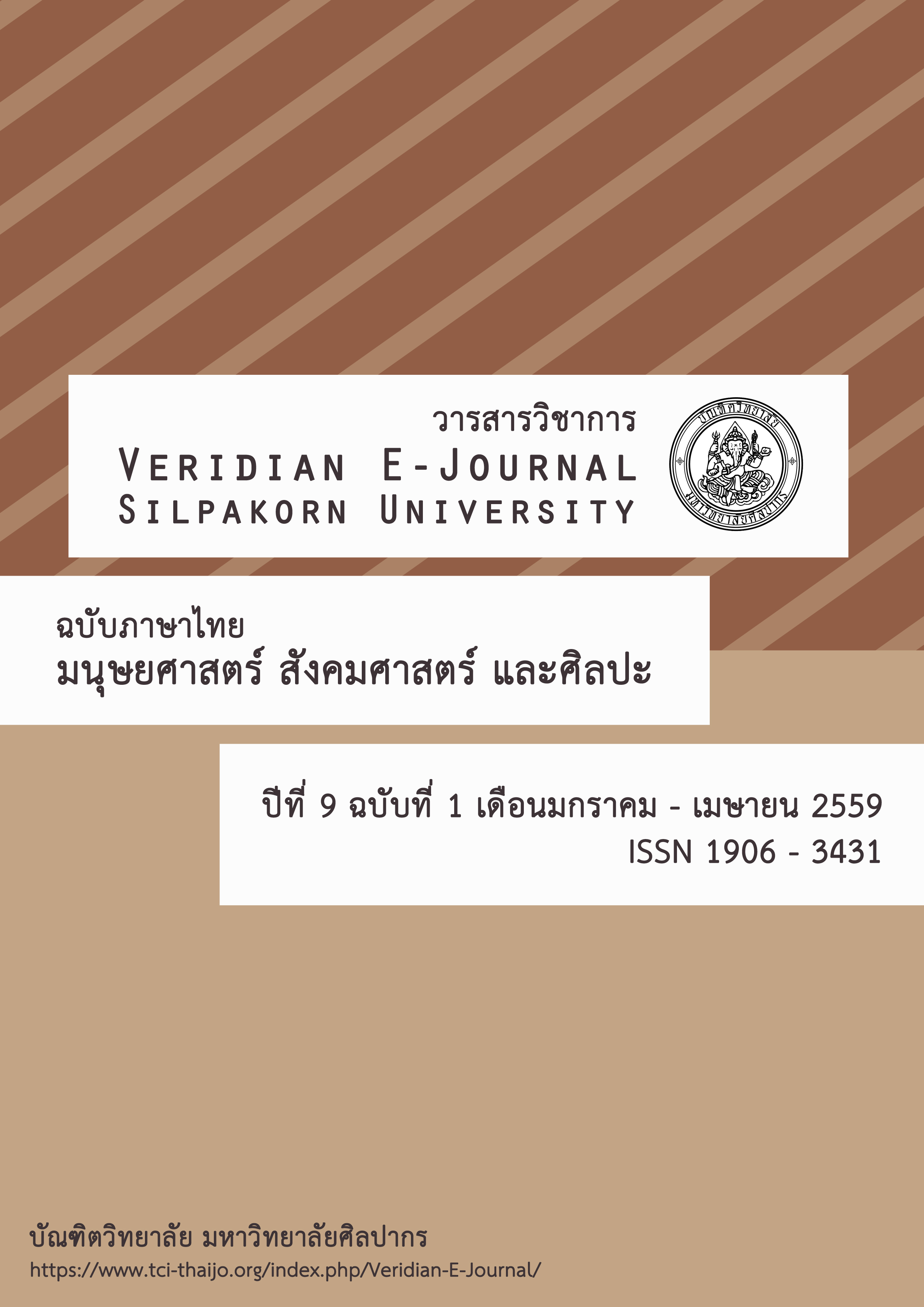มโนทัศน์เรื่องนาคของชนชาติไท
Main Article Content
บทคัดย่อ
บทคัดย่อ
การวิจัยนี้มีวัตถุประสงค์เพื่อศึกษาความคิดเรื่องงู นาค และมังกร ของชนชาติต่างๆวิเคราะห์มโนทัศน์เรื่องนาคของชนชาติไทที่สะท้อนให้เห็นจากงานวรรณกรรม งานศิลปะ ความเชื่อ ประเพณี และพิธีกรรม และวิเคราะห์การดำรงอยู่ของมโนทัศน์เรื่องนาคของชนชาติไทในปัจจุบัน การศึกษาดังกล่าวผู้วิจัยศึกษาจากข้อมูลเอกสารและข้อมูลสนามโดยใช้ระเบียบวิธีและกรอบความคิดทางคติชนวิทยาและมานุษยวิทยา ทั้งนี้แหล่งข้อมูลที่ศึกษา คือ กลุ่มชนชาติไทนอกประเทศไทย ได้แก่ ไทใหญ่ ไทลื้อ ไทเขิน ไทลาว ไทดำ ไทขาว ไทแดง และ ไทอาหม และกลุ่มชนชาติไทยในประเทศ ได้แก่ ไทยยวน ไทยลื้อ ไทยใหญ่ ไทยลาว ไทยอีสาน ไทยสยาม ภาคกลาง และไทยสยาม ภาคใต้
ผลการวิจัยพบว่า ความคิดเรื่องงู นาค และมังกรของชนชาติต่าง ๆ เป็นความคิดร่วมของมนุษยชาติที่น่าสนใจและยังคงสืบทอดมาถึงปัจจุบัน ส่วนมโนทัศน์เรื่องนาคของชนชาติไทที่สะท้อนให้เห็นจากงานวรรณกรรม งานศิลปะ ความเชื่อ ประเพณี และพิธีกรรมนั้น ประมวลได้ 15 มโนทัศน์ ได้แก่ มโนทัศน์นาคเป็นบรรพบุรุษ มโนทัศน์นาคเป็นสิ่งศักดิ์สิทธิ์ มโนทัศน์นาคในฐานะที่เป็นเทพ มโนทัศน์นาคมีอิทธิฤทธิ์ พลัง อำนาจ มโนทัศน์นาคศรัทธาในพระพุทธศาสนาหรือเกี่ยวข้องกับพระพุทธศาสนา มโนทัศน์นาคเป็นผู้ปกปักรักษาสถานที่สำคัญหรือบ้านเมือง มโนทัศน์นาคมีรูปลักษณ์คล้ายงูใหญ่และรูปลักษณ์ที่ท่อนบนเป็นมนุษย์ท่อนล่างเป็นงู มโนทัศน์เกี่ยวกับที่อยู่ของนาค มโนทัศน์นาคมีอยู่จริง มโนทัศน์นาคเป็นเจ้าแห่งน้ำและแผ่นดิน มโนทัศน์นาคที่เกี่ยวข้องกับการเกษตรและความอุดมสมบูรณ์ มโนทัศน์นาคกับการสร้างบ้านเรือนและที่อยู่อาศัย มโนทัศน์นาคกับโหราศาสตร์ มโนทัศน์นาคเป็นผู้ช่วยเหลือมนุษย์และมโนทัศน์รูปลักษณ์ของนาคมีความงามทางศิลปะ
การวิเคราะห์มโนทัศน์เรื่องนาคของชนชาติไทในปัจจุบันพบว่ายังคงปรากฏการรับรู้เรื่องนาค เนื่องจากมีการถ่ายทอดมโนทัศน์ดังกล่าวจากรุ่นสู่รุ่น โดยเฉพาะในท้องถิ่นที่เป็นสังคมแบบดั้งเดิมและมีประชากรในวัยอาวุโสจะมีความเข้มข้นของการปรากฏและการสืบทอดมโนทัศน์เรื่องนาคสูง ทั้งนี้บทบาทของ “สื่อ” นั้นเป็นปัจจัยสำคัญที่ส่งผลให้มโนทัศน์เรื่องนาคยังคงดำรงอยู่ในการรับรู้ของคนในกลุ่มชนชาติไทปัจจุบัน อย่างไรก็ตามยังพบว่าบางมโนทัศน์มีการนำไปปฏิบัติน้อยลง ซึ่งเนื่องมาจากปัจจัยทางสังคม การศึกษา ความเจริญก้าวหน้าทางเทคโนโลยีและวิทยาการสมัยใหม่ได้เข้ามามีบทบาทสำคัญในการดำเนินชีวิตของคนในกลุ่มชนชาติไท โดยเฉพาะในสังคมที่เป็นสังคมเมือง อนึ่ง มโนทัศน์เรื่องนาคในฐานะเป็นต้นทุนทางวัฒนธรรมในการสร้างสรรค์สิ่งต่าง ๆ นั้น พบว่า มีบทบาทต่อการเสริมสร้างเศรษฐกิจของชุมชนและขณะเดียวกันก็เป็นการสืบทอดมโนทัศน์เรื่องนาคให้ดำรงอยู่ในสังคมของชนชาติไทไปพร้อมกันด้วย
Abstract
The objectives of this research study are: to examine different ethnic groups’ notions of snakes, nagas, and dragons; to analyze the ethnic Tai’s concepts of nagas reflected in literary works, arts, beliefs, traditions, and rituals; and to analyze the ethnic Tai’s current concepts of nagas. The data of this study were collected from both existing documentation and fieldworks conducted, following the research methodology and theoretical frameworks in folklore and anthropology. The informants of this study consisted of two groups: 1) ethnic Tai minority groups residing outside Thailand including Shan, Tai Lü, Tai Kheun, Tai Lao, Tai Dam, Tai Khao, Tai Daeng, and Tai Ahom; 2) ethnic Tai minority groups residing in Thailand including Thai Yuan, Thai Lü, Shan, Thai Laos, Thai Isan, Thai Siam in the central, and Thai Siam in the south.
The findings of this study indicate that the different ethnic groups’ notions of snakes, nagas, and dragons demonstrate some interesting commonalities across different ethnic groups of mankind which have been passed on from previous generations to the current generation. In addition, the ethnic Tai’s concepts of nagas as reflected in literary works, arts, beliefs, traditions and rituals can be classified into 15 types. That is, a naga could be regarded as a forefather, a sacred being, a divine being, a being with magical power, a being with strength and might, a being with faith in or connection with Buddhism, a guardian of important places or cities, a large serpent, a dwelling, an existing being, a god of water and earth, a being representing agriculture and fertility, a being related to homes and living quarters, a being connected to astrology, a human helper, and physical appearance with artistic beauty.
The analysis of the ethnic Tai’s current concepts of nagas reveals that the informants are well aware of the naga accounts because these concepts have been passed from generation to generation. Especially in a conservative society, the more the elderly people, the more conscious they are of the naga concepts and the higher degree of inheritance. The role of “media” is considered crucial, contributing to the prevalent existence of the naga concepts in the ethnic Tai groups. However, certain concepts are decreasingly observed, due to social and academic factors, modern technology, and new discoveries that have a tremendous impact on the ethnic Tai’s way of life, especially those residing in an urban society. At this juncture, the concept of nagas as a cultural cost in creating items has exerted an impact on strengthening the economy of the ethnic Tai community while concurrently maintaining the naga concepts.
